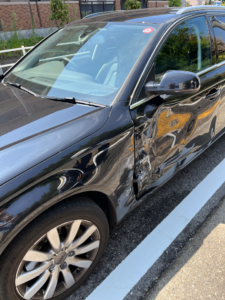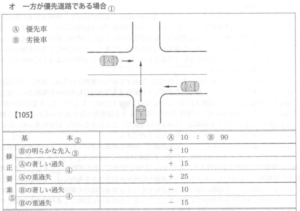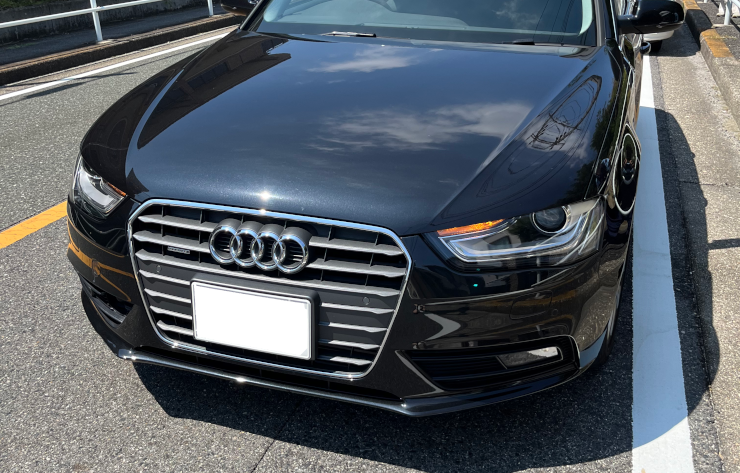
ジジイは、2014年にAudi A4 Avante クワトロを新車で購入し、ちょうど今年で10年目でした。このAudiのステーションワゴンは走行距離は3.7万km、一切故障もなく、デザインも気に入っていたので、まだ10年は乗れるかなと思っていた2024年の8月、優先道路を走っていたら、側道から出てきた車にぶつけられてしまいました。ショックでした。
I bought a new Audi A4 Avante quattro in 2014, and it was exactly 10 years ago this year. The mileage was 37,000 km. This Audi station wagon had never had any problems, and I liked the design, so I thought I could keep it for another 10 years. In August 2014, while I was driving on a priority road, I was hit by a car coming out of a side road. I was shocked.
結局、相手側の保険会社からの物損保証と自己資金で別の車に乗り換えることになったのですが、今回、改めて車を運転する際にドライバーとして注意すべきことと、乗り換える際の車選びで色々と勉強したので、同じような経験を今後するかもしれないみなさんとこの経験を共有したいと思い、ブログに掲載することにしました。
In the end, I had to switch to another car using the property damage coverage from the other party’s insurance company and my own funds, but this time I learned a lot about what drivers should be careful of when driving a car and how to choose a new car, so I decided to share my experience with anyone who may have a similar experience in the future, and post it on my blog.

上の写真の通り、助手席側のドアと後部座席のドアがひどく破損してドアも開きません。相手の方は、若い女性でした。彼女は申し訳なさそうに「すみません。左ばかり気にして右側を見ていませんでした」と彼女の車が私の車に衝突した理由を私に説明しました。下はドライブレコーダーの映像です。この映像を調べると、ジジイが彼女の車を認知してから衝突までの時間は2秒です。ジジイは避けようとハンドルを切るも、衝突は防げませんでした。
As you can see in the photo above, the passenger door and the back door were so badly damaged that they wouldn’t open. The driver of the other car was a young woman. She explained to me with an apologetic look, “I’m sorry. I was only looking left and didn’t look right,” explaining why her car collided with mine. Below is the footage from the dashcam. When we look at this footage, we can see that it was two seconds from when the old man noticed her car to when the collision occurred. The old man turned the steering wheel to avoid it, but he couldn’t prevent the collision.
ジジイの当初の考えは、相手の車が優先道路への侵入時の右確認を怠ってこちらの車の側面に衝突した事実から事故の責任は相手100%:ジジイ0%のはずと思い込んでいました。そのため、ジジイが入っていた任意自動車保険会社のセゾン火災自動車保険(おとなの保険)の担当者にはその主張をしました。保険会社の担当者の方は、「お気持ちはわかりますが、9:1になってしまいます」の一点張りで、話は平行線で先に進みません。実は、私の知識不足でその通りであることは、弁護士に相談して初めて理解できました。
My initial thinking was that because the other car had failed to check right when entering the priority road and collided with my car from the side, the other car should be 100% responsible for the accident and 0% for me. Therefore, I made this argument to the person in charge at Saison Automobile and Fire Insurance, the voluntary automobile insurance company that I had contracted. The person in charge at the insurance company just said, “I understand how you feel, but it will be 90:1,” and the conversation went nowhere. In fact, it was only after consulting a lawyer that I realized that this was true due to my lack of knowledge.
ただ、この経験で感じたのは、保険会社がきちんと判例を元に説明してくれたら、すんなり納得できて無駄な時間や苛立ちも抑えられたのにということです。相談した弁護士の方から教えてもらったのが、下図の判例を元にした事故仲裁の考え方です。この図は、「別冊判例タイムズ 民事交通訴訟における過失相殺率の認定基準(東京地裁民事交通訴訟研究会編)」からの出典です。
However, what I felt from this experience was that if the insurance company had properly explained the situation based on legal precedents, I would have been able to understand it more easily and avoid wasting time and frustration. The lawyer I consulted with taught me the idea of accident arbitration based on legal precedents shown in the diagram below. This diagram is taken from “Special Edition Case Law Times: Criteria for determining the rate of contributory negligence in civil traffic lawsuits (edited by the Tokyo District Court Civil Traffic Litigation Research Group).”
優先道路を走っている車と側道から出てきた車の衝突の場合、基本の認定基準は優先道路側の車Aが10%、側道側の車Bが90%と決まっているのだそうです。Bに著しい過失があった場合に初めてAの過失が-10%され、0%になるのです。このようなケースでの著しい過失は、Bのドライバーがスマホの画面を見ていたなどとこの資料には記載されています。
In the case of a collision between a car traveling on a priority road and a car coming out from a side road, the basic criteria for determination are that car A on the priority road is 10% at fault, and car B on the side road is 90% at fault. Only if car B is grossly negligent will car A’s fault be reduced by 10% to 0%. This document states that gross negligence in such a case would be the driver of car B looking at the screen of their smartphone, etc.
つまり、ドライブレコーダーの映像からはその事実までは確認ができないので、事故直後に相手のドライバーに「スマホを見ていたよね?」と指摘して相手が認めることでもない限り、優先道路側のドライバーの過失がゼロになることはないのです。ここで一つ学んだことは、事故直後に「スマホ閲覧」を相手のドライバーにチェックすることです。相手も動揺している時ですから、事故直後に「スマホ見ていたよね?」と聞かれて事実なら「はい、すみません」と認める可能性が高いです。そうすれば、こちらの過失はゼロになるというわけです。
In other words, since the facts cannot be confirmed from the footage of the dashcam, the driver on the priority road will not be at zero fault unless you point out to the other driver immediately after the accident that “you were looking at your smartphone, weren’t you?” and they admit it. One thing I learned here is to check with the other driver about “looking at her/his smartphone” immediately after the accident. The other driver will also be shaken up at the time, so if you ask them “you were looking at your smartphone, weren’t you?” immediately after the accident, there is a high chance they will admit “yes, I’m sorry” if it is true. This will eliminate your fault.

それと、私がドライブレコーダーの映像をもとに自分の主張を文書にまとめてセゾン火災自動車保険さんの担当者の方に送ったところ、指摘されたのが「予見義務」です。上記の判例を元にした仲裁案が優先道路側90:側道側10の割合になっているのがこの「予見義務」だそうです。「側道から車が出てくるかもしれないな」と減速して万が一に備える義務があるというのが交通ルールの基本。免許の更新の際の講習会できっと説明されているのだと思いますが、恥ずかしながら、「予見義務」という言葉は初めて聞きました。みなさんはどうでしょうか?車を運転するドライバーの責任として、これからはこの「予見義務」に注意をして運転をしなければと反省しています。
Also, when I wrote up my argument based on the video from my dashcam and sent it to the person in charge at Saison Automobile and Fire Insurance, he pointed out the “duty to foresee.” The arbitration proposal based on the above precedent has a ratio of 90% on the priority road and 10% on the side road, which is the “duty to foresee.” The basic rule of traffic is that I have the duty to slow down and prepare for the unlikely event that a car might come out of the side road. I’m sure it’s explained in the seminar when I renew my license, but I’m ashamed to say that this is the first time I’ve heard the term “duty to foresee.” What about you? I’ve decided that as a driver, I have a responsibility to be mindful of this “duty to foresee” when driving from now on.
さて、事故の双方の責任分担はこれで解決したのですが、問題は壊れた車をどうするかです。実は、保険でカバーしてくれるのは、事故車の現在経済価値の範囲内です。ジジイのAudiは10年前の車なので、その価値は115万円。ところが、修理費用を見積もってもらったところ、137万円となりました。つまり、115万円については、相手側の保険で90%、私の車両保険で10%の按分で双方の保険会社に負担してもらえるのですが、差額の22万円は、被害者である私が負担するのが法律で決まっているのだそう。
Now that the division of responsibility for the accident between the two parties has been resolved, the question is what to do about the damaged car. In fact, insurance will only cover the current economic value of the damaged car. My Audi is a 10-year-old car, so its value is 1.15 million yen. However, when I got an estimate for the repair costs, it came to 1.37 million yen. In other words, the other party’s insurance will cover 90% of the 1.15 million yen, and my vehicle insurance will cover 10%, but the law stipulates that I, the victim, must cover the difference of 220,000 yen.
法律的には、私は115万円で買える車に乗り換えることができるので、自分の意思で修理するなら差額は自己負担になるという立て付けなのです。確かに理論的にはそうですが、車をぶつけられて、挙句のはてにお気に入りの車を修理するのに自己負担しないといけないというのは感情的には納得ができませんでした。でも、法律で決まっているなら、諦めるしかありません。
Legally, I can switch to a car that costs 1.15 million yen, so if I repair it of my own volition, I have to pay the difference in price. That’s true in theory, but emotionally I couldn’t accept the idea of having my car hit and then having to pay for repairs to my favorite car. But if it’s the law, I have no choice but to accept it.
そこで、どうせ自分のお金を使うなら、ということで、Audiの修理はやめて新しい車に乗り換えることにしました。10年間、車の購入経験もなかったので、改めて車選びで勉強になったので、そのこともブログに書いて共有しようと思います。
So, since I was going to spend my own money anyway, I decided to stop repairing the Audi and switch to a new car. I hadn’t bought a car for 10 years, so I learned a lot from choosing a car, and I’d like to share that in my blog.
ジジイの車選びの予算は保険金115万+最大285万円の自己資金で合計400万円。
この予算を前提に考えたのが乗り換え候補の車が、メルセデスCステーションワゴンの中古車です。
My budget for choosing a car was 4 million yen, consisting of 1.15 million yen insurance and a maximum of 2.85 million yen of his own money.
Based on this budget, the car I was considering as a replacement was a used Mercedes C station wagon.


